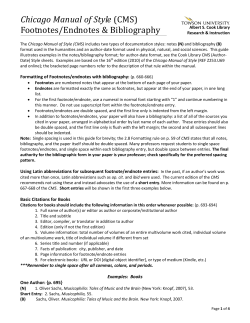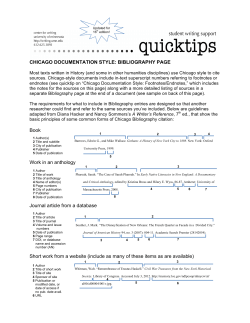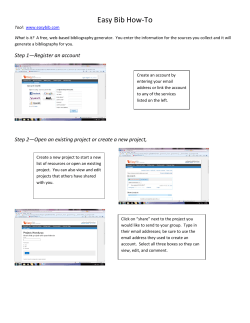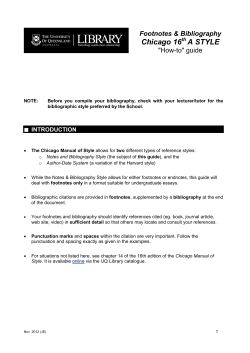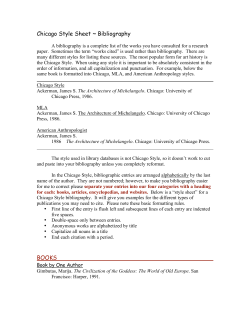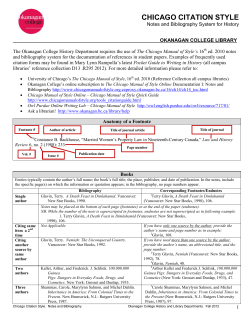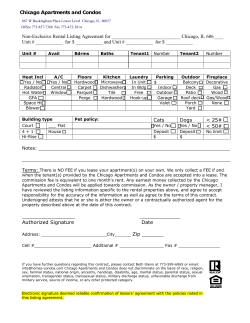
Document 303098
1 Chicago Manual of Style Guide, 16th edition (2010) Prepared by the Librarian Council of the Halton Catholic District School Board Last updated February 2014 What is Chicago Style? This guide illustrates the Chicago Manual of Style documentation format for sources most frequently used by students. You must adhere to the format and punctuation as shown. Please note there are other accepted styles that vary from discipline to discipline. Be sure to ask your teacher if there is a preferred style for your assignment. Citations and bibliographies are used for two reasons. One is to inform your teacher (or any other reader) about the resources you used to write your essay/report/project. The other, and more importantly, is to acknowledge those sources and to differentiate between your thoughts and/or opinions and the facts you found in your research. If you do not cite your sources you are committing a form of academic dishonesty known as plagiarism. Plagiarism is the theft of someone else’s words or ideas and can result in a mark of 0, whether done intentionally or not. You should use citations: If you are stating facts or statistics, e.g. If you are providing someone else’s opinion, e.g. You do not need to use citations: If you are giving your own opinion or stating common knowledge, e.g. The earth is round. H20 is water. I think that humanity will realize the importance of the environment and change their ways. Glossary: Bibliography: an alphabetical list of sources of information appearing at the end of a research paper. Citation: identifying a source of information for a direct or paraphrased quote. Endnotes: numbered citations placed at the end of the research paper indicating the source for direct or paraphrased quote Footnotes: numbered citations placed at the bottom of the page indicating the source for direct or paraphrased quotes. Quote: the copying of a part of a book, article, CD-ROM or Internet document and enclosing it in quotation marks. Paraphrase: putting an idea from a book, article, CD-ROM or Internet document into your own words (must be cited). URL: the Uniform Resource Locator is the address and method used to locate a specific resource on the Internet (e.g. http://www…) Working Document, 2014 Secondary Schools Librarian Council Halton Catholic District School Board 2 Print Books General Format and Punctuation of Print Citation Endnote/Footnote Format (Chicago section 14.15): List the author, title, and facts of publication, in that order, separated by commas. The facts of publication are enclosed in parentheses. Example: First name, Last name, Title of Book Italicized and Capitalized (Publication city: Publisher, publication year), page(s). Bibliography Format (Chicago section 14.16): List the author, title, and facts of publication, in that order separated by periods; the facts of publication are not enclosed in parentheses. Example: Last name, First name. Title of Book Italicized and Capitalized. Publication city: Publisher, publication year. Additional information: Citations referenced in the essay text must be numbered in superscript format. Use the endnote or footnote function under the References tab in MS Word to create the superscript numbers. Footnotes or endnotes corresponding to the essay text citations are numbered in regular format. (Chicago section 14.4) Numbers should be placed at the end of the clause or sentence to which they refer and should be placed after any and all punctuation. Book, Single Author (Chicago section 14.18): Endnote/Footnote: 1. Alan Weisman, The World Without Us (Toronto: Harper Collins, 2007), 168. Short Endnote/Footnote: 1. Weisman, World Without Us, 168. Bibliography: Weisman, Alan. The World Without Us. Toronto: Harper Collins, 2007. 3 Book, Two Authors (Chicago section 14.18): Endnote/Footnote: 2. Robert Prior and Thomas Wilson, The First World War, 3rd ed. (London: Cassel, 2003), 10. Short Note: 2. Prior and Wilson, First World War, 10. Bibliography: Prior, Robert and Thomas Wilson. The First World War. 3rd ed. London: Cassel, 2003. Additional information: This example also includes proper placement of an edition statement (Chicago Manual section 14.118) The order of the authors’ names should be the same as they appear on the title page. For a book with two authors, note that only the first listed name is inverted in the bibliography entry. Book with Three Authors (Chicago section 14.18): Endnote/Footnote: 3. Alison E. Buchanan, John Smith, and Heather Davis, Deciding for Others: The Ethics of Surrogate Decision Making (Berkeley: University of California Press, 2003), 55-56. Short Note: 3. Buchanan, Smith, and Davis, Deciding for Others, 55-56. Bibliography: Buchanan, Alison E., John Smith, and Heather Davis. Deciding for Others: The Ethics of Surrogate Decision Making. Berkeley: University of California Press, 2003. Book with More than Three Authors (Chicago section 14.18, 14.76): Endnote/Footnote: 4. Hutchins, Chris et al., Astronomy: A Guide to the Stars (New York: W.W. Norton and Company, 2007), 51-52. Short Note: 4. Hutchins et al., Astronomy, 51-52. Bibliography: Hutchins, Chris, Amy Lewis, Sean Smart, Carol Tan, and Mark Cullen. Astronomy: A Guide to the Stars. New York: W.W. Norton and Company, 2007. Additional information: Word order and punctuation are the same as for two or three authors. In the note, however, cite only the name of the first- listed author, followed by et al. The order of the authors’ names should be the same as they appear on the title page. List all of the authors in the bibliography. 4 Book with an Editor (Chicago section 14.87): Endnote/Footnote: 6. Sharon Fraser, ed., A Woman's Place: Seventy Years in the Lives of Canadian Women (Toronto: Key Porter Books, 2001), 176. Short Note: 6. Fraser, ed., A Woman’s Place, 176. Bibliography: Fraser, Sharon, ed. A Woman's Place: Seventy Years in the Lives of Canadian Women. Toronto: Key Porter Books, 2001. Additional information: In both the Notes and Bibliography the abbreviations ed.or eds., comp. or comps., or trans. follow the name, preceded by a comma. The Bible (Chicago section 14.253 and 14.254): Endnote/Footnote: 7. 1 Cor. 13:1-13 (New Jerusalem Bible). 8. John 3:1-8 (NJB). Additional information: Biblical references rarely appear in the Bibliography. It usually appears in Parenthetical (bracketed) or note references. The Bible reference should include book (in roman numerals and is usually abbreviated), chapter and verse – never a page number. A colon is used between chapter and verse. There are many versions of the Bible, therefore the name of the version is recorded at the end of the entry as supplementary bibliographic information. In this example, the version is the New Jerusalem Bible. In a subsequent entry you can abbreviate the version to (NJB). Corporation/Association/Committee as Author (Chicago section 14.92): Endnote/Footnote: 6. American Psychiatric Association, Practice Guidelines for the Treatment of Patients with Borderline Personality Disorder (Arlington: American Psychiatric Association, 2001), 56. 7. UNDP. Human Development Report 2013: The Rise of the South: Human Progress in a Diverse World (New York: UNDP, 2013), 57) Short Note: 6. American Psychological Association, Practice Guidelines, 56. 5 7. UNDP, Human Development Report 2013: The South: Human Progress in a Diverse World, 57. Bibliography: American Psychiatric Association. Practice Guidelines for the Treatment of Patients with Borderline Personality Disorder. Arlington: American Psychiatric Association, 2001. UNDP. Human Development Report 2013: The Rise of the South: Human Progress in a Diverse World. 2013. Additional information: If a publication issued by an organization, association, or corporation carries no personal author's name on the title page, the organization is listed as author in a bibliography, even if it is also given as publisher. Work in a Collection, Anthology, or Edited Book (Chicago section 14.111-14.112): Endnote/Footnote: 8. Peter Lurie, “Mad Cow Disease is a Threat to American Meat,” in Food-Borne Illnesses, ed. Karen F. Balkin (Farmington Hills, MI: Dushkin Publishing, 2004), 16. Short Note: 8. Lurie, “Mad Cow Disease,” 16. Bibliography: Lurie, Peter. “Mad Cow Disease is a Threat to American Meat.” In Food-Borne Illnesses, edited by Karen F. Balkin, 271-79. Farmington Hills, MI: Dushkin Publishing, 2004. Additional information: When a specific chapter (or other titled part of a book) is cited in the notes, the author’s name is followed by in, followed by the title of the book. Note the use of the state abbreviation in the place of publication. According to the Chicago Manual of Style, if the place is a major city, such as London, Paris, New York, etc., you do not need to include the state, province or country. If the place is a little-known location, you should include the state, province, or country according to standard postal abbreviations. In this example, MI stands for Michigan. For Canadian provinces, use ON, BC, AB, etc. (Rule 14.136) Translation (Chicago section 14.88): Endnote/Footnote: 9. Leo Tolstoy, War and Peace, trans. Richard Pevear and Larissa Volokhonsky (New York: Vintage Books, 2008), 205. Short Note: 9. Tolstoy, War and Peace, 205. 6 Bibliography: Tolstoy, Leo. War and Peace. Translated by Richard Pevear and Larissa Volokhonsky. New York: Vintage Books, 2008. Additional information: The translated work of one author is normally listed with the author's name appearing first and the translator's name appearing after the title, preceded by translated by or trans. In the bibliography the word translated must be spelled out in full. Graphic novels or Manga (Chicago section 14.88): Endnote/Footnote: 10. Alessandro Mainardi, The Life of Pope John Paul II: In Comics, illus. Werner Maresta (New York: Papercutz, 2006), 64. Short Note: 10. Mainardi, John Paul II, 64. Bibliography: Mainardi, Alessandro. The Life of Pope John Paul II: In Comics. Illustrated by Werner Maresta. New York: Papercutz, 2006. Additional information: The Chicago Manual of Style does not contain an example for this format. Use the previous example for translated works as a guide, substituting the illustrator in place of the translator. The world illustrated can be abbreviated in the note, but written in full in the bibliography. Encyclopedia and dictionary entries (Chicago section 14.247): Endnote/Footnote: 11. The New Encyclopedia Britannica, 15th ed., s.v. “China.” 12. The Canadian Oxford Dictionary, 2nd ed., s.v. “misdemeanour.” 13. Encyclopedia Brittanica, 15th ed., s.v.v. “rocket fuel” “rocket science” Additional information: Well-known reference books, such as major dictionaries and encyclopaedias, are normally cited in notes only, rather than in bibliographies. This is the Chicago Style rule but check with your teacher for their preference. The facts of publication are often omitted, but the edition (if not the first) must be specified. When referencing an alphabetically arranged work, cite the item (not the volume or page number) preceded by s.v. (sub verbo, or "under the word." For multiple word title use the plural form s.v.v.) 7 Scholarly Journal (Chicago section 14.175): Endnote/Footnote: 13. Jeff Latimer and Laura Casey Foss. "The Sentencing of Aboriginal and Non-Aboriginal Youth Under the Young Offenders Act: A Multivariate Analysis," Canadian Journal of Criminology and Criminal Justice 47, no.3 (2005): 481. Short Note: 13. Latimer and Foss, “The Sentencing of...,” 481. Bibliography: Latimer, Jeff, and Laura Casey Foss. "The Sentencing of Aboriginal and Non-Aboriginal Youth Under the Young Offenders Act: A Multivariate Analysis." Canadian Journal of Criminology and Criminal Justice 47, no.3 (2005). Additional information: The numbers 47, no. 3 in this example represent the volume and issue number of the journal. They must always be given in that order. Magazine article (Chicago section 14.175, 14.199): Endnote/Footnote: 14. Michael Petrou, “Syria Exposes Hollowness of Today’s British Labour Party,” Maclean’s, September 5, 2013, 12. Short Note: 14. Petrou, “Syria Exposes Hollowness,” 12. Bibliography: Petrou, Michael. “Syria Exposes Hollowness of Today’s British Labour Party.” Maclean’s. September 5, 2013. Additional information: If no author is available, begin the citation after the endnote number with the Title of the Article. Newspaper article- With or without an author (Chicago section 14.203-14.213): Endnote/Footnote: 15. Barrie McKenna, “Green Acres: the Soaring Value of Canada’s Farmland,” Globe & Mail, September 5, 2013. Short Note: 15. McKenna, “Green Acres.” If the above article did not have the author listed, you would begin the entry of the endnote/footnote with the title of the article standing in place of the author (Rule 14.207). See below: 15. “Green Acres: the Soaring Value of Canada’s Farmland,” Globe & Mail, September 5, 2013. 8 Bibliography: McKenna, Barrie. “Green Acres: the Soaring Value of Canada’s Farmland.” Globe & Mail. September 5, 2013. If the above article did not have an author listed, you would begin the entry of the bibliography with the title of the newspaper standing in place of the author (Rule 14.207). See below: Globe & Mail. “Green Acres: the Soaring Value of Canada’s Farmland.” September 5, 2013. Additional information: Omit the initial article The from the title of the newspaper when giving it in footnotes/endnotes or a bibliography (i.e. The Globe & Mail becomes Globe & Mail). (Rule 14.210) The date of the newspaper must be written out in full (i.e. September not Sept.) Internet/Web Publications Person as website author (Chicago section 14.245): Endote/Footnote: 19. Amanda Mabillard, “Romeo and Juliet Study Guide,” Shakespeare Online, last updated November 15, 2011, http://www.shakespeare-online.com/playanalysis/. Short Note: 19. Mabillard, “Romeo and Juliet Study Guide.” Bibliography: Mabillard, Amanda. “Romeo and Juliet Study Guide.” Shakespeare Online. Last updated November 15, 2011. http://www.shakespeare-online.com/playanalysis/. Additional information: When listing the website’s date, you can use the terminology “published”, “last modified,” or “last updated”, depending on how it is phrased on the website. If you cannot find a date, use the date you accessed the website and the phrase “Accessed.” Eg. Accessed April 12, 2013, Organization as Website Author (Chicago section 14.243-14.245): Endnote/Footnote: 20. “Two Million Syrians are Now Refugees,” Oxfam Canada, published September 3, 2013, http://www.oxfam.ca/news-and-publications/news/two-million-syrians-are-now-refugees. Short Note: 20. Oxfam Canada, “Two Million Syrians.” 9 Bibliography: “Two Million Syrians are Now Refugees.” Oxfam Canada. Published September 3, 2013. http://www.oxfam.ca/news-and-publications/news/two-million-syrians-are-now-refugees. Additional information: When there is no author given, begin the Endnote and Bibliography with the title of the webpage in quotations, followed by the organization. When the website is published by a major organization, give the name in Italics. Online Book (Chicago section 14.167): Endnote/Footnote: 21. Rafe Esquith, Teach Like Your Hair’s on Fire: the Methods and Madness Inside Room 56 (New York: Penguin, 2007), under “What a Wonderful World,” Google Books, books.google.com/books?isbn=1101201916. Short Note: 21. Esquith, Teach Like, under “What a Wonderful World.” Bibliography: Esquith, Rafe. Teach Like Your Hair’s on Fire: the Methods and Madness Inside Room 56. New York: Penguin, 2007. Google Books. books.google.com/books?isbn=1101201916. Additional Information: In the footnote or endnote, instead of giving page numbers (as many online books do not have them), include the name of the section the information was retrieved from. E-book (Chicago section 14.166): Endnote/Footnote: 22. Malcolm Gladwell, Outliers: the Story of Success (New York: Little, Brown & Co., 2011), Kobo edition, chap. 1. Short Note: 22. Gladwell, Outliers, chap. 1. Bibliography: Gladwell, Malcolm. Outliers: the Story of Success. New York: Little, Brown & Co., 2011. Kobo edition. 10 Online encyclopedia (Chicago section 14.248-14.249): Endnote/Footnote: 23. Canadian Encyclopedia Online, s.v. “Karst Landform,” by D.C. Ford, accessed September 13, 2013, http://www.thecanadianencyclopedia.com/articles/karst-landform. Short Note: 23. Canadian Encyclopedia Online, s.v. “Karst Landform.” Bibliography: Ford, D.C. “Karst Landform.” In Canadian Encyclopedia Online. Accessed September 13, 2013, http://www.thecanadianencyclopedia.com/articles/karst-landform. Additional Information In the absence of a posted publication or revision date for the cited entry, supply an access date. Online image: Endnote/Footnote: 24. Beverly Joubert, “African Elephant (Loxodonta Africana),” photograph, accessed September 17, 2013, http://animals.nationalgeographic.com/animals/mammals/african-elephant/. Short Note: 24. Joubert, “African Elephant.” Bibliography: Joubert, Beverly. “African Elephant (Loxodonta Africana).” Photograph. Accessed September 17, 2013. http://animals.nationalgeographic.com/animals/mammals/african-elephant/. Additional information: The Chicago Manual of Style does not contain clear guidelines for online images. In order to maintain consistency with your citations, follow the guidelines for website citations as closely as possible. Give the information in the following order: Author/creator (if given), title of the image in quotations, medium, year, web address or DOI. Many words can be used to describe the medium: photograph, painting, cartoon, graph, map, etc. If you cannot find a year of publication for the image, include an access date, such as in the above example. Article, Online newspaper (Chicago section 14.203-14.213): Endnote/Footnote: 25. Victoria Ptashnik, “Ottawa Lawyer Accused of Misappropriating $500,000 Living in Paris for its ‘Medical Facilities,’” Toronto Star, April 17, 2013, www.thestar.com. Short Note: 25. Ptashnik, “Ottawa Lawyer Accused.” 11 Bibliography: Ptashnik, Victoria. “Ottawa Lawyer Accused of Misappropriating $500,000 Living in Paris for its ‘Medical Facilities.’” Toronto Star, April 17, 2013. www.thestar.com. Article, Online journal (Chicago section 14.170-14.198): Endnote/Footnote: 26. Alexander Noyes, “Securing Reform? Power Sharing and Civil-Security Relations in Kenya and Zimbabwe,” African Studies Quarterly 13, no. 4 (2013): 31, http://www.africa.ufl.edu/asq/v13/v13i4a2.pdf. Short Note: 26. Noyes, “Securing Reform?,” 31. Bibliography: Noyes, Alexander. “Securing Reform? Power Sharing and Civil-Security Relations in Kenya and Zimbabwe.” African Studies Quarterly 13, no. 4 (2013): 27-52. http://www.africa.ufl.edu/asq/v13/v13i4a2.pdf. Additional information: If the journal article is available in PDF and contains page numbers, list them. If not, just give the URL or DOI. The title of the article is given in quotation marks, while the journal title is given in italics. Online magazine article (Chicago section 14.199-14.202): Endnote/Footnote: 27. Tony Perrottet, “Where was the Birthplace of the American Vacation?” Smithsonian Magazine, April 2013, http://www.smithsonianmag.com/travel/Where-Was-the-Birthplace-of-the-AmericanVacation-199170351.html. Short Note: 27. Perrottet, “American Vacation.” Bibliography: Perrottet, Tony. “Where Was the Birthplace of the American Vacation?”. Smithsonian Magazine, April 2013. http://www.smithsonianmag.com/travel/Where-Was-the-Birthplace-of-the-American-Vacation199170351.html. 12 Article from a database (EBSCO/Gale) (Chicago section 14.271-14.272): Endnote/Footnote: 28. Hendrika Vande Kemp, “Dreams and Recovery From Trauma,” Journal of Psychology and Theology 33, no. 4 (2005): 315, General OneFile, Gale (accessed April 18, 2013). Short Note: 28. Vande Kemp, “Dreams and Recovery,” 315. Bibliography: Vande Kemp, Hendrika. “Dreams and Recovery From Trauma.” Journal of Psychology and Theology 33, no. 4 (2005): 313-315. General OneFile, Gale (accessed April 18, 2013). Additional information: In this example, General OneFile is the name of the database the article came from. The database name should be given in italics. Gale is the program that hosts all the databases. List that as well, so that if your teacher wants to look at your source, they will know which host and database to search in. If the article provides a DOI, stable link or Permalink, you may include that as well at the end of your note and bibliography entry. Two or More Works by the Same Author (Chicago section 6.91 and 14.63-14.67): Bibliography: Atwood, Margaret. Alias Grace. Toronto: McClelland & Stewart, 1994. —. Blind Assassin. Toronto: Seal Books, 2000. —. Surfacing. Toronto: PaperJacks Publishing, 1972. Additional information: For successive entries by the same author, a 3-em dash replaces the name after the first appearance. The entries are arranged alphabetically by title. 13 Sample Title Page in Chicago Style Title centered 1/3 down Name centered halfway down Class, Instructor and Date centered on double-spaced lines 2/3 down 14 Sample Page in Chicago Style Page one is the title page; this is page two. Margins are 1”, text is double spaced. Last name and page number are at the
© Copyright 2025
